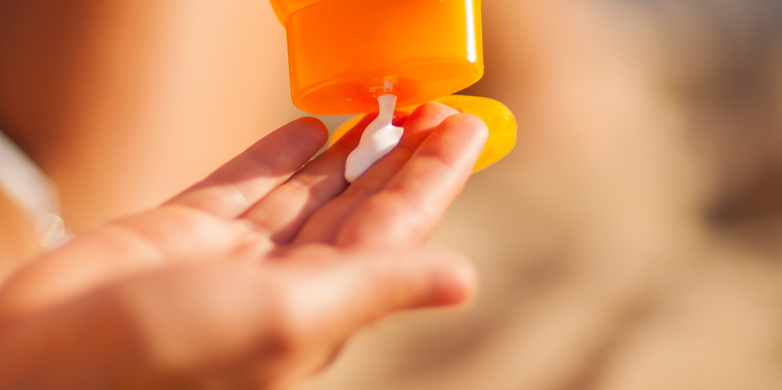Sunscreens may be harmful
Researchers at ETH Zurich asked consumers in German-speaking Switzerland how often they used sunscreens and other personal care products. The collected data make for interesting reading: part of the population applies sunscreen to the skin in quantities that could potentially be harmful to health.
Many sunscreens and skin care products – especially anti-ageing creams – contain chemical ultraviolet (UV) filters. These substances absorb UV radiation from the sun and thus protect our skin from damage. In a representative survey, ETH researchers looked into how often German-speaking Swiss consumers used sunscreens and other personal care products containing UV filters. Furthermore, they determined the concentrations of UV filters contained in these products. This information allowed the researchers to estimate, for the first time, the amount of UV filters the general population is exposed to.
The results of the new study by the team of researchers from the group of Konrad Hungerbühler, Professor for Safety and Environmental Technology, are important, because some of the substances are not without controversy. It is suspected that some can trigger allergies or influence the endocrine system. The main finding of the study is that part of the Swiss-German population is exposed to questionable UV filters in quantities that may be harmful to health.
The UV filter most commonly used by Swiss-German consumers, butyl methoxydibenzoylmethane, is relatively harmless to both humans and the environment. However, the controversial substances ethylhexyl methoxycinnamate (EHMC) and octocrylene follow in the second and third places. The researchers evaluated the data from the consumer and analytical surveys in detail for both substances.
Allergenic substance above the limit
Past studies suggest that octocrylene can trigger allergies. The number of new cases reported by physicians in the scientific literature has increased in recent years.
Based on the available data in the scientific literature, the researchers assumed that the use of 4.9 or 14.8 micrograms of octocrylene per square centimetre of skin per day does not represent a hazard (the reference value depends on the product type and gender of the consumer). However, the survey results showed that on some days half the population applies at least 87 micrograms of octocrylene per square centimetre of skin. This means that they are exceeding the limit by 5 to 17 times. One in 20 even uses 190 micrograms per square centimetre, i.e. 12-38 times more. The differences between various age groups of adults are negligible, but the quantities are slightly higher in children than in adults.
“Octocrylene is increasingly used in skin care products; nowadays, the substance is contained in a large number of sunscreens and face creams,” says Eva Manová, ETH doctoral student and the study’s first author. The substance serves primarily to stabilise other UV filters in the product (especially those against UVA light), which increases the shelf life and effectiveness of the product.
Children particularly exposed
Studies show that the second target substance, EHMC, interferes with hormonal functions in the body. Until recently, it was widely used in sunscreens, but nowadays it has often been replaced by less harmful and more stable substances. However, it is still used in many cosmetic products such as make-up foundations and face creams – possibly because the substance is relatively cheap.
The consumer survey showed: On sunny days, 5 percent of the population applies at least 0.43 milligrams of EHMC per kilogram of body weight to their skin. This is nearly half the reference value determined by the Danish Environmental Protection Agency in a risk assessment. Based on published data obtained in animal studies the agency found that one milligram of EHMC per day and kilogram of body weight can interfere with hormonal functions.
The Swiss survey also showed that young children are most exposed to the substance: on sunny days 1 percent of children under the age of four nearly reaches the reference value with 0.94 milligrams or more. “This is linked to the fact that some sunscreen products containing EHMC are specifically advertised for use by children,” says Manová.
Further studies recommended
“Because octocrylene and EHMC are used by parts of the population in German-speaking Switzerland in health-relevant quantities, we recommend an evaluation of their safety and limit values more precisely in future and we call for further research,” says Natalie von Götz, senior scientist in Hungerbühler’s group and lead author of the current study. Indeed, previous studies have shown that both substances can enter the body through the skin. However, little research has been carried out into what proportion of the applied quantities actually enters the body and with what mechanisms and speed the body processes the substances. Therefore, further studies on skin absorption and metabolism of these substances in the body are needed. Depending on the outcome, it might be advisable to reduce the currently allowed maximum concentrations in the products.
“The extent of consumer exposure to individual UV filters largely depends on the presence of the specific substances in the products sold in the respective market,” says ETH doctoral student Manová. As this presence varies greatly from one country to the next, the results from Switzerland cannot be fully applied to other countries. This makes country-specific surveys like this study very important. This research work has been financially supported by the Swiss Federal Office of Public Health.
Literature reference
Manová E, von Goetz N, Hungerbühler K: Aggregate consumer exposure to UV filter ethylhexyl methoxycinnamate via personal care products, Environmental International 2015, 74: 249-257, doi: external page10.1016/j.envint.2014.09.008call_made
Manová E, von Goetz N, Hungerbühler K: Ultraviolet filter contact and photocontact allergy: consumer exposure and risk assessment for octocrylene from personal care products and sunscreens. British Journal of Dermatology 2014. 174: 1368-1374, doi: external page10.1111/bjd.13372call_made

